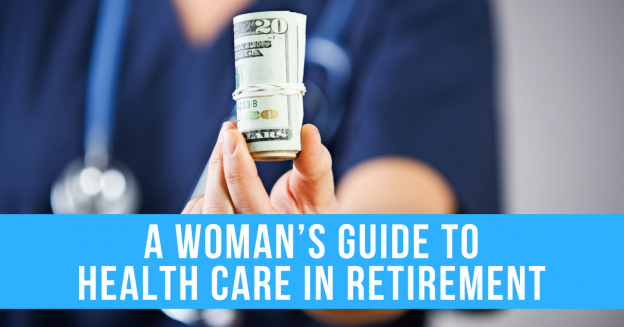
At any age, health care is a priority. But when you retire, you should probably focus more on health care than ever before. That’s why it’s particularly important for women to factor in the cost of health care, including long-term care, as part of their retirement plan.
How much you’ll spend on health care during retirement generally depends on a number of variables including when you retire, how long you live, your relative health, and the cost of medical care in your area. Another important factor to consider is the availability of Medicare. Generally, you’ll be eligible for Medicare when you reach age 65. But what if you retire at a younger age?
You’ll need some way to pay for your health care until Medicare kicks in. Your employer may offer health insurance coverage to its retiring employees, but this is the exception rather than the rule. If your employer doesn’t extend health benefits, you may be able to get insurance coverage through your spouse’s plan. If that’s not an option, you may need to buy a private health insurance policy (which could be costly) or extend your employer-sponsored coverage through COBRA.
Medicare
As mentioned, most Americans automatically become entitled to Medicare when they turn 65.
In fact, if you’re already receiving Social Security benefits when you’re 65, you won’t even have to apply—you’ll be automatically enrolled in Medicare. However, you will have to decide whether you need only Part A coverage (which is premium-free for most retirees) or if you want to also purchase Part B coverage.
Medicare Part A, B, C
➢ Part A, commonly referred to as the hospital insurance portion of Medicare, can help pay for your inpatient hospital care, plus home health care and hospice care.
➢ Part B helps cover other medical care such as physician services, laboratory tests, and physical therapy.
➢ You may also choose to enroll in a managed care plan or private fee-for-service plan under Medicare Part C (Medicare Advantage) if you want to pay fewer out-of-pocket health-care costs.
And if you don’t already have adequate prescription drug coverage or belong to a Medicare Advantage Plan, you should consider joining a Medicare prescription drug plan offered in your area by a private company or insurer that has been approved by Medicare.
Unfortunately, Medicare won’t cover all of your health-related expenses. For some types of care, you’ll have to satisfy a deductible and make co-payments. That’s why many retirees purchase a Medigap policy.
Medigap
Unless you can afford to pay out of pocket for the things that Medicare doesn’t cover, including the annual co-payments and deductibles that apply to certain types of services, you may want to buy some type of Medigap policy when you sign up for Medicare Part B.
➢ In most states, there are 10 standard Medigap policies available. Each of these policies offers certain basic core benefits, and all but the most basic policy (Plan A) offer various combinations of additional benefits designed to cover what Medicare does not.
Although not all Medigap plans are available in every state, you should be able to find a plan that best meets your needs and your budget.
When you first enroll in Medicare Part B at age 65 or older, you have a six-month Medigap open enrollment period. During that time, you have a right to buy the Medigap policy of your choice from a private insurance company, regardless of any health problems you may have. The company cannot refuse you a policy or charge you more than other open enrollment applicants.
Long-term care
Long-term care refers to the ongoing services and support needed by people who have chronic health conditions or disabilities. Long-term care can be expensive. An important part of planning is deciding how to pay for these services.
Buying long-term care (LTC) insurance is an option. While premiums may be costly, having LTC insurance may allow you to elect where you receive your care, the type of care you receive, and who provides care to you. Many LTC insurance policies pay for the cost of care provided in a nursing home, assisted-living facility, or at home, but the cost of coverage generally depends on your age and the policy benefits and options you purchase. And premiums can increase if the insurer raises its overall rates.
Even with LTC insurance, you still may have some expenses not covered by LTC insurance.
For example:
➢ Not all policies provide coverage for care in your home. While the cost of in-home care may be less than the cost of care provided in a nursing home, it can still be quite expensive.
➢ Most policies allow for the selection of an elimination period of between 10 days and 1 year, during which time you are responsible for payment of care.
➢ The LTC insurance benefit is often paid based on a daily or monthly maximum amount, which may not be enough to cover all of the costs of care.
➢ While lifetime coverage may be selected, it can increase the premium cost significantly, and some policies may not offer that option. Another option that can be valuable, but also increase the premium expense considerably, is cost-of-living or inflation protection, which annually increases the daily insurance benefit based on a certain percentage.
➢ Most common LTC insurance benefit periods last from 1 year to 5 years, after which time the insurance coverage generally ends regardless of whether care is still being provided.
To encourage more individuals to buy long-term care insurance, many states have enacted Partnership programs that authorize private insurers to sell state-approved long-term care Partnership policies. Partnership policy owners, who expend policy benefits on long-term care services, will qualify for Medicaid without having to first spend all or most of their remaining assets (assuming they meet income and other eligibility requirements).
Medicaid and government benefits
Government benefits provided primarily through a state’s Medicaid program may be used to pay for long-term care. To qualify for Medicaid, however, assets and income must fall below certain limits, which vary from state to state. Often, this requires spending down assets, which may mean using savings to pay for care before qualifying for Medicaid.
If you are a veteran, you may be eligible for long-term care services for service-related disabilities and for other health programs such as nursing home care and at-home care through the Department of Veterans Affairs (VA). If you don’t have service-related disabilities, you may also be eligible for VA benefits if you are unable to pay for the cost of necessary care. Visit the Department of Veterans Affairs website (www.va.gov) for more information.
Other health-care factors to consider
It’s clear that health care is an important factor in retirement planning. Here are some tips to consider:
➢ Evaluate your present health and project your future medical needs. Considering your family’s health history may help you determine the type of care you might need in later years.
➢ Don’t presume Medicare and Medigap insurance will cover all your expenses. For example, Medicare (Parts A and B) does not cover the cost of routine eye exams, most eyeglasses or contact lenses, or routine hearing exams or hearing aids. Include potential out-of-pocket costs in your plan.
➢ Even if you have Medicare and Medigap insurance, there are premiums, deductibles, and co-payments to consider.
You may have already begun saving for your retirement, or you could be retired already, but if you fail to include the cost of health care as a retirement expense, you’re likely to find that health-care costs can sap retirement income in a hurry, potentially leaving you financially strapped.
Need help with your insurance and retirement planning?
Click here for a no-obligation planning session. Our goal is to help make sure health care expenses do
NOT deplete your hard-earned life savings! We’ve helped hundreds of women in the Los Angeles community against this growing problem.
VIDEO: Are Soaring Health Care Costs Hurting the U.S. Economy?












 Finding the balance between securing safe, comfortable care for elderly parents and paying for it can be almost impossible. Many people are surprised to discover that Medicare doesn’t cover long-term care costs, also known as custodial care.
Finding the balance between securing safe, comfortable care for elderly parents and paying for it can be almost impossible. Many people are surprised to discover that Medicare doesn’t cover long-term care costs, also known as custodial care.

 The numbers, however, point to the fact that more than half of us will need some form of assistance as we get older.
The numbers, however, point to the fact that more than half of us will need some form of assistance as we get older.